
A gladiator was an armed combatant who entertained audiences in the Roman Republic and Roman Empire in violent confrontations with other gladiators, wild animals, and condemned criminals. Some gladiators were volunteers who risked their lives and their legal and social standing by appearing in the arena. Most were despised as slaves, schooled under harsh conditions, socially marginalized, and segregated even in death.

Hoplites were citizen-soldiers of Ancient Greek city-states who were primarily armed with spears and shields. Hoplite soldiers used the phalanx formation to be effective in war with fewer soldiers. The formation discouraged the soldiers from acting alone, for this would compromise the formation and minimize its strengths. The hoplites were primarily represented by free citizens – propertied farmers and artisans – who were able to afford a linen or bronze armour suit and weapons. It also appears in the stories of Homer, but it is thought that its use began in earnest around the 7th century BC, when weapons became cheap during the Iron Age and ordinary citizens were able to provide their own weapons. Most hoplites were not professional soldiers and often lacked sufficient military training. Some states maintained a small elite professional unit, known as the epilektoi or logades since they were picked from the regular citizen infantry. These existed at times in Athens, Sparta, Argos, Thebes, and Syracuse, among other places. Hoplite soldiers made up the bulk of ancient Greek armies.

The Samnites were an ancient Italic people who lived in Samnium, which is located in modern inland Abruzzo, Molise, and Campania in south-central Italy.
Maniple was a tactical unit of the Roman Republican armies, adopted during the Samnite Wars. It was also the name of the military insignia carried by such units.

A peltast was a type of light infantry originating in Thrace and Paeonia and named after the kind of shield he carried. Thucydides mentions the Thracian peltasts, while Xenophon in the Anabasis distinguishes the Thracian and Greek peltast troops.

The scutum was a type of shield used among Italic peoples in antiquity, most notably by the army of ancient Rome starting about the fourth century BC.
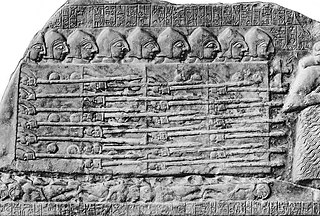
The phalanx was a rectangular mass military formation, usually composed entirely of heavy infantry armed with spears, pikes, sarissas, or similar polearms tightly packed together. The term is particularly used to describe the use of this formation in ancient Greek warfare, although the ancient Greek writers used it to also describe any massed infantry formation, regardless of its equipment. Arrian uses the term in his Array against the Alans when he refers to his legions. In Greek texts, the phalanx may be deployed for battle, on the march, or even camped, thus describing the mass of infantry or cavalry that would deploy in line during battle. They marched forward as one entity.
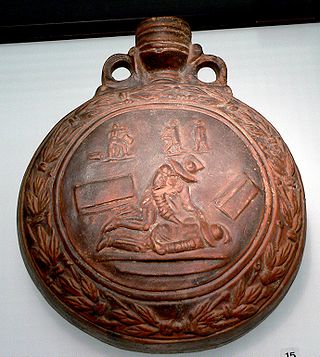
The murmillo was a type of gladiator during the Roman Imperial age. The murmillo-class gladiator was adopted in the early Imperial period to replace the early Gallus, named after the warriors of Gaul. As the Gauls inhabiting Italy had become well integrated with the Romans by the time of the reign of Augustus, it became undesirable to portray them as enemy outsiders; the Gallus-class gladiator thus had to be retired.
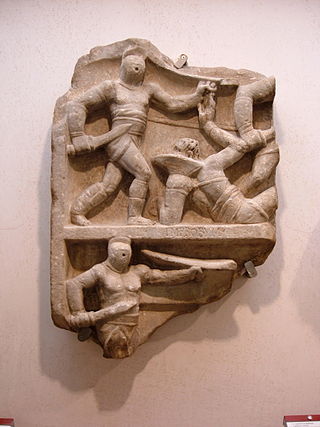
A secutor was a class of gladiator in ancient Rome. Thought to have originated around 50 AD, the secutor was armed similarly to the Murmillo gladiator and like the Murmillo, was protected by a heavy shield. A secutor usually carried a short sword, a gladius, or a dagger. The secutor was specially trained to fight a retiarius, a type of lightly armoured gladiator armed with a trident and net.

A retiarius was a Roman gladiator who fought with equipment styled on that of a fisherman: a weighted net, a three-pointed trident, and a dagger (pugio). The retiarius was lightly armoured, wearing an arm guard (manica) and a shoulder guard (galerus). Typically, his clothing consisted only of a loincloth (subligaculum) held in place by a wide belt, or of a short tunic with light padding. He wore no head protection or footwear.
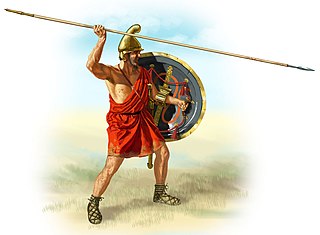
The army of the Kingdom of Macedon was among the greatest military forces of the ancient world. It was created and made formidable by King Philip II of Macedon; previously the army of Macedon had been of little account in the politics of the Greek world, and Macedonia had been regarded as a second-rate power.
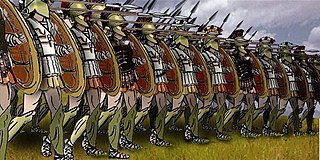
Heavy infantry consisted of heavily armed and armoured infantrymen who were trained to mount frontal assaults and/or anchor the defensive center of a battle line. This differentiated them from light infantry who are relatively mobile and lightly armoured skirmisher troops intended for screening, scouting, and other tactical roles unsuited to soldiers carrying heavier loads. Heavy infantry typically made use of dense battlefield formations, such as shield wall or phalanx, multiplying their effective weight of arms with force concentration.
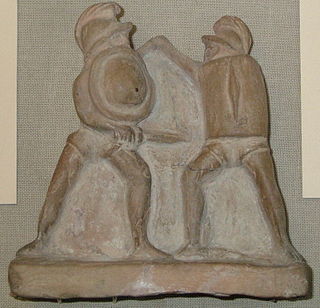
The Thraex, or Thracian, was a type of Roman gladiator, armed in the Thracian style with a small rectangular, square or circular shield called a parmula and a very short sword with a slightly curved blade called a sica, intended to maim an opponent's unarmoured back. His other armour included armoured greaves, a protective belt above a loincloth, and a helmet with a side plume, visor and high crest. Ludia's female gladiators used the same weapons and armour.

The sica is a short sword or large dagger of ancient Illyrians, Thracians, and Dacians, it was also used in Ancient Rome. It was originally depicted as a curved sword and many examples have been found in what are today Croatia, Albania, Bosnia and Herzegovina, Bulgaria, Serbia, and Romania. It is also depicted on Trajan's Column; notably the Dacian king Decebalus is depicted dying by suicide with one.

The Gladiator Mosaic is a famous set of 5 large mosaics of gladiators and venators and two smaller ones. The mosaics are dated to the first half of the 4th century and are now installed in the Salone of the Galleria Borghese in Rome. They were discovered in 1834 on the Borghese estate at Torrenova, on the Via Casilina outside Rome. Prince Francesco Borghese Aldobrandini requested the excavations be completed. It is believed to have decorated a cryptoporticus of an inner peristylum for a large domus. The mosaics were removed from excavations and restored by Gaetano Ruspi and Filippo Scaccia in 1839. These panels reinvigorated the Borghese Collection after it had shrunk following the sale of much of the collection to Napoleon I.
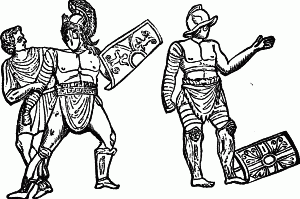
A Samnite was a Roman gladiator who fought with equipment styled on that of a warrior from Samnium: a short sword (gladius), a rectangular shield (scutum), a greave (ocrea), and a helmet. Warriors armed in such a way were the earliest gladiators in the Roman games. They appeared in Rome shortly after the defeat of Samnium in the 4th century BC, apparently adopted from the victory celebrations of Rome's allies in Campania. By arming low-status gladiators in the manner of a defeated foe, Romans mocked the Samnites and appropriated martial elements of their culture.

The history of Thracian warfare spans from the 10th century BC up to the 1st century AD in the region defined by Ancient Greek and Latin historians as Thrace. It concerns the armed conflicts of the Thracian tribes and their kingdoms in the Balkans. Apart from conflicts between Thracians and neighboring nations and tribes, numerous wars were recorded among Thracian tribes.

Illyrian weaponry played an important role in the makeup of Illyrian armies and in conflicts involving the Illyrians. Of all the ancients sources the most important and abundant writings are those of Ennius, a Roman poet of Messapian origin. Weapons of all sorts were also placed intact in the graves of Illyrian warriors and provide a detailed picture for archaeologists on the distribution and development of Illyrian weaponry.
The dimachaeri were a type of Roman gladiator that fought with two swords. The name is the Latin-language borrowing of the Greek word διμάχαιρος meaning "bearing two knives".


















